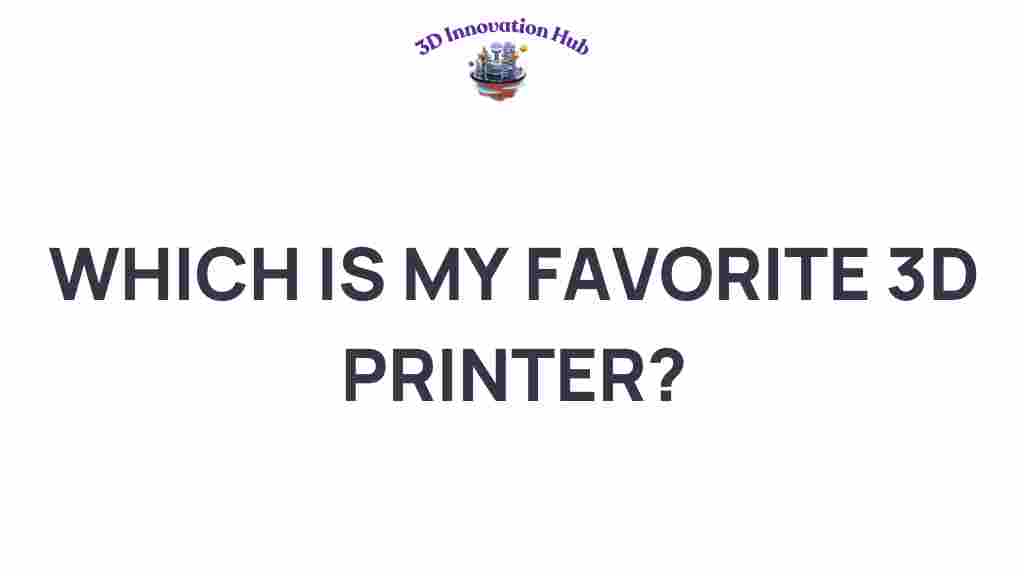Unraveling the Mystery: Which 3D Printer Reigns Supreme?
In the ever-evolving world of 3D printing, selecting the best 3D printer can be a daunting task. With a multitude of options available on the market, each boasting unique features and capabilities, it’s crucial to understand what sets them apart. This article aims to provide a comprehensive comparison of various 3D printers, focusing on their key features, performance quality, and overall value. We will delve into the latest technology advancements in 3D printing and help you find the ideal printer for your needs.
The Rise of 3D Printing Technology
The innovation in 3D printing technology has transformed industries ranging from manufacturing to healthcare. With the ability to create complex designs and prototypes quickly, 3D printers have become essential tools for engineers, designers, and hobbyists alike. As we explore the options available, we’ll consider factors such as:
- Print quality
- Speed of printing
- Material compatibility
- User-friendliness
- Cost-effectiveness
Key Features to Consider in a 3D Printer
When evaluating 3D printers, several features are crucial for determining their suitability for your specific needs:
- Build Volume: The size of the objects you can print is dictated by the build volume of the printer.
- Print Resolution: Higher resolution results in finer details in your prints.
- Supported Materials: Different printers support various filaments, such as PLA, ABS, PETG, and more.
- Ease of Use: Consider how intuitive the interface and setup process is.
- Community and Support: A strong user community can be invaluable for troubleshooting and tips.
Comparing the Best 3D Printers
To help you identify which 3D printer reigns supreme, we will compare some of the best models currently available, focusing on their features, performance, and user reviews.
1. Prusa i3 MK3S+
The Prusa i3 MK3S+ is widely recognized for its exceptional quality and reliability. This printer has received rave reviews from users around the globe, and it is often touted as one of the best 3D printers for both beginners and experienced users alike.
- Build Volume: 250 x 210 x 210 mm
- Print Resolution: 50 microns
- Supported Materials: PLA, ABS, PETG, and more
- Features:
- Automatic bed leveling
- Filament sensor
- Power recovery
The Prusa’s strong community support and comprehensive documentation make it an excellent choice for those entering the world of 3D printing.
2. Creality Ender 3 V2
The Creality Ender 3 V2 is a budget-friendly option that does not compromise on quality. It has become a favorite among hobbyists looking for an affordable yet reliable 3D printer.
- Build Volume: 220 x 220 x 250 mm
- Print Resolution: 100 microns
- Supported Materials: PLA, ABS, TPU, and more
- Features:
- Silent stepper drivers
- Upgraded glass bed
- Easy assembly
With a wealth of online resources and modifications available, the Ender 3 V2 is ideal for those who enjoy tinkering with their 3D printer.
3. Anycubic Photon Mono X
If you’re looking to venture into resin printing, the Anycubic Photon Mono X is a top contender. This printer stands out for its high precision and remarkable print quality.
- Build Volume: 192 x 120 x 245 mm
- Print Resolution: 50 microns
- Supported Materials: Various types of resin
- Features:
- Fast printing speed
- Large color LCD screen
- Easy-to-use slicing software
The Photon Mono X is perfect for those who prioritize detail and quality in their 3D prints, especially for miniatures and intricate designs.
Step-by-Step Process for Choosing the Right 3D Printer
Choosing the right 3D printer can be simplified by following these steps:
Step 1: Define Your Needs
Consider what you plan to print. Are you looking for functional parts, artistic creations, or prototypes? Defining your needs will help narrow down the options.
Step 2: Set a Budget
Determine how much you’re willing to spend. There are excellent options at various price points, so setting a budget can help streamline your search.
Step 3: Research Models
Look for reviews and comparisons of different 3D printers. User feedback is invaluable for understanding real-world performance.
Step 4: Check Community Support
A vibrant community can greatly enhance your experience. Look for printers with active forums and resources.
Step 5: Purchase and Setup
Once you’ve chosen a printer, purchase it and follow the setup instructions carefully to ensure optimal performance.
Troubleshooting Common 3D Printing Issues
<pEven the best 3D printers can encounter problems. Here are some common issues and their solutions:
Issue 1: Poor Adhesion to the Build Plate
Solution: Ensure the build plate is clean and level. Experiment with different bed temperatures and adhesion aids like glue sticks or painter’s tape.
Issue 2: Stringing Between Prints
Solution: Adjust the retraction settings in your slicing software. Increase the retraction distance or speed to minimize stringing.
Issue 3: Layer Misalignment
Solution: Check the printer’s mechanics. Ensure belts are tight, and the frame is stable. Re-calibrate the printer if necessary.
Conclusion: The Best 3D Printer for You
In conclusion, the best 3D printer for you depends on your specific needs, budget, and level of expertise. The Prusa i3 MK3S+ is perfect for those seeking high quality and extensive community support, while the Creality Ender 3 V2 is fantastic for budget-conscious hobbyists. For those interested in resin printing, the Anycubic Photon Mono X offers unparalleled detail.
As technology and innovation in 3D printing continue to advance, staying informed through comparisons and reviews will ensure you make the right choice. For more information on various 3D printers, you can check this comprehensive guide.
Whichever 3D printer you choose, embrace the journey of creating and innovating in the fascinating world of 3D printing!
This article is in the category and created by 3D Innovation Hub Team
